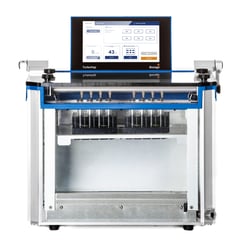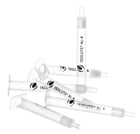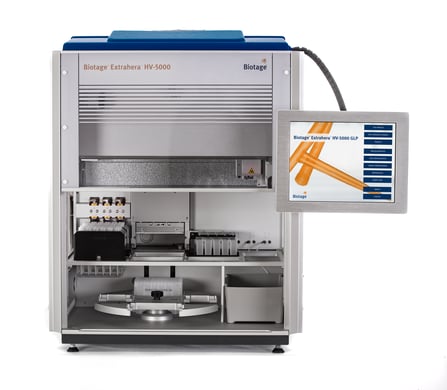If you are working in an environmental lab and encounter tissue samples and highly contaminated petroleum soil samples that create a lot of noise and interference on your analytical instruments, then you may need to apply an alumina cleanup to your workflow.
If this is a new cleanup procedure for your lab you will want to do your due diligence on what forms of alumina are available and which one you will need to apply to your workflow. I am going to share knowledge on the forms of alumina available and how to apply them in a workflow to streamline your process.
If the term alumina cleanup does not ring a bell with you, I would like to take a step back and define what it is. The sorbent alumina itself is a granular/solid form of aluminum oxide that is very porous. Its function as a cleanup is to separate target analytes from compounds that interfere due to their different polarity.
When I first experimented with alumina, I found out that there are different forms (acid, neutral and basic) available based on the pH of the sorbent and each one of them had its pros and cons. For instance, if you are using acidic alumina (which typically has a pH of 4-5) you would want to apply this sorbent to highly acidic compounds you want to separate. If you were to use a neutral or basic sorbent of alumina, the acids would be absorbed and almost impossible to elute off that that point. If you were to use neutral alumina (pH of 6-8) for separating, then this would be a great option for phthalates. It is less active than the basic sorbent but still a great option for its application. The last option which is the strongest of the three is the basic alumina (pH of 9-10). This option is great for not only basic compounds but neutrals ones as well. One thing to note is that all types of Alumina are somewhat moisture sensitive. ISOLUTE Alumina is moisture controlled to <0.1% moisture. In addition, the basic alumina is very sensitive to moisture, and you want to ensure your extract has been fully dried and your sorbent source (bulk sorbent or cartridge) is dry and or new out of the package. If the sorbent has been compromised, then the cleanup process will not work even if you have prepped and followed the procedure perfectly. Also, some polar solvents such as acetone and ethyl acetate are not recommended as eluting solvents with this option.
Before you clean up your extract there is one critical step. You will need to solvent exchange the extract to a solvent such as hexane (most used in environmental applications), pentane or methylene chloride and concentrate to 2mL. I have worked with several evaporation instruments in my career. Determining the one that works for your lab all depends on how efficient you would like to have your sample workflow. One that I like is the Biotage TurboVap® . The reason why I like this evaporator is that it can be converted many ways to accommodate your workflow. For instance, you can run high volume samples with six positions or 48 positions with multiple types of concentration tubes or vials. It’s a great option to have for what your workflow demands day to day I consider the Biotage TurboVap like a multitool, you have the availability to configure a system based on your sample extract volumes and throughput.
In the sample preparation lab having the right tools for the job can streamline the overall process. For instance, if you choose to manually clean and dry your bulk sorbent before packing your own columns this could take some time and may make it a time-consuming process. The best option is to purchase vendor cartridges, such as the Biotage ISOLUTE®. Vendor cartridge options are convenient and made to comply with method criteria to ensure a streamlined implementation.
A big benefit with vendor cartridges that I really like is that you can semi automate them or even fully automate the cleanup procedures and, in some cases, haveentire sample batches cleaned up. I like utilizing the batch cleanups with my workflow as it can lead to streamlining multiple processes. For instance, if I use a Biotage®Extrahera™ HV-5000 to clean twenty-four samples at once with 6ml cartridges I could then take the entire extract tray with my alumina cleaned extracts and place them directly into a TurboVap® EH and concentrate all twenty-four at once. This would eliminate any potential analyte loss with twenty-four transfer steps and any potential sample mislabeling. It has been a real gamechanger for me by avoiding transfer steps while keeping my sample accountability in check as my extract trays are labeled.
When you apply an alumina cleanup to your sample preparation process your overall workflow will increase sample productivity and your results will be more consistent and easier for the analyst to determine on the chromatograph. This will result in a faster overall turnaround of samples back to clients.
If you would like to know about other cleanup techniques and sorbent options, please look at our latest blog - Why is florisil cleanup necessary with sample extracts?
Follow below link to learn what options you have for Alumina cleanups.

 Organic Workflow
Organic Workflow Peptide Workflow
Peptide Workflow Scale-Up Flash Purification
Scale-Up Flash Purification  Sample Preparation
Sample Preparation Biomolecule Purification
Biomolecule Purification Oligo synthesis
Oligo synthesis Scavengers and Reagents
Scavengers and Reagents Service & Support
Service & Support Accessories & Spare parts
Accessories & Spare parts Investors
Investors Reports & News
Reports & News The Share
The Share Corporate Governance
Corporate Governance Calendar
Calendar Sustainability
Sustainability Our Offering
Our Offering Our History
Our History Our Locations
Our Locations Leadership
Leadership
